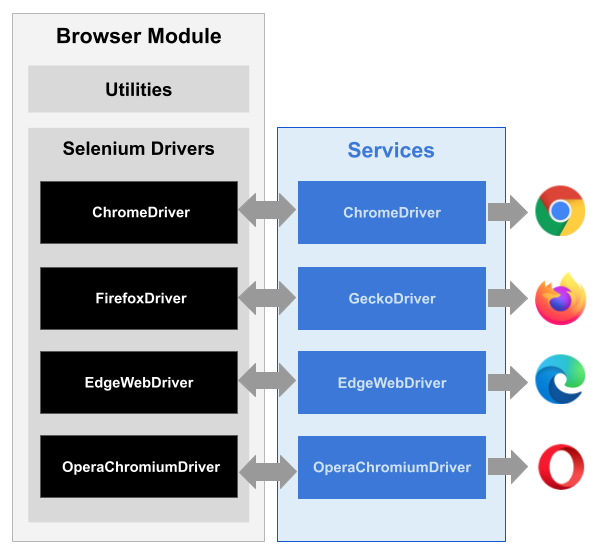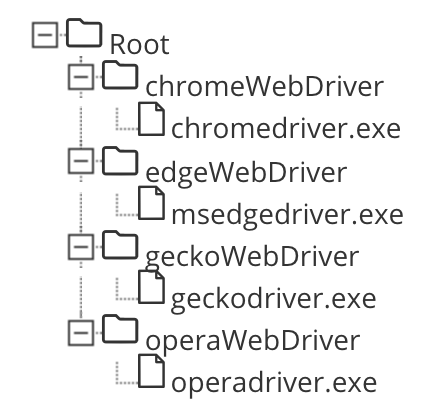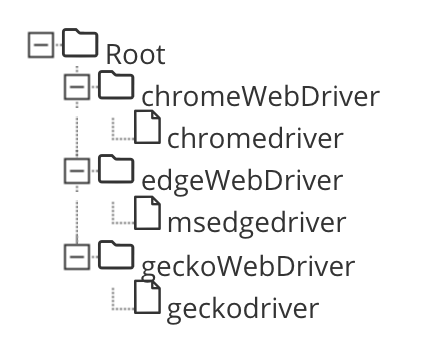| The capabilities described on this page are included in Appian's standard capability tier. Usage limits may apply. |
The Browser module contains a number of Java methods that enable a robotic task to open and interact with web browsers. Through this module, you can navigate to a URL and interact with the web page just as a human would: click on the page controls, select options, enter values in text fields, retrieve HTML items, and more.
This page describes how to integrate browser methods into your robotic task using the Java module. See the low-code Browser module page for guidance in an easier and more robust development experience.
To use the Browser module in your projects, you first must include the module dependency in the pom.xml.
Browser actions architectureCopy link to clipboard
Browser actions require Selenium to work properly and interact with browsers.
Automatically update web driversCopy link to clipboard
Note: Appian can only update web drivers automatically when the robotic task uses Chrome, Firefox, or Edge. If you are using Edge (IE Mode), you must add and maintain the web driver support file manually.
Instead of having to manually download and add web drivers to your support files, Appian can automatically maintain Selenium web drivers for you. This option is turned off by default.
When you select this option, Appian automatically provides the necessary web drivers for the browser you are using in your robotic tasks and the task recorder. When you allow Appian to add and update web drivers automatically, you avoid the common problem of having a web driver go out of date when the corresponding browser updates.
Note: The option to automatically provide web drivers is not supported for Appian Government Cloud (AGC) customers.
To allow Appian to automatically provide web drivers:
- Go to the Settings tab.
- In the Configuration tab, go to Security policies.
- Select Allow Appian to provide selenium web drivers.
- Click Save security policies.
That's it! With this option selected, there isn't anything else to configure.
ComponentsCopy link to clipboard
This area describes each of the components needed to work with the Appian RPA Browser actions:
- Java Selenium drivers: Appian RPA uses the Selenium WebDriver API, which contains different language-specific implementations, such as Java. The Java implementations, included in the Maven dependency
selenium-java, are called drivers. It is important to know this terminology to avoid confusion. - Servers: executable programs that drivers communicate with. Drivers use servers to interact with browsers. These servers, sometimes known as proxies, are necessary and are available to download as external components, since they are developed by third parties. This page uses the term servers to avoid confusion.
-
Browsers: the web browsers to use in the automation. The following table summarizes browser and operating system compatibility:
Windows Mac Linux Chrome Supported Supported Supported Firefox Supported Supported Supported Edge Supported Supported Unsupported Edge (IE Mode) Supported Unsupported Unsupported Opera Unsupported Unsupported Unsupported Note: Opera Browser is only supported for RPA 9.11 and previous. Support was removed in RPA 9.12.
The following image shows how all these components are connected:

Note: Edge (IE mode) requires the Internet Explorer driver support file.
Different servers available for each supported browser:
- ChromeDriver: server to link Browser actions with Chrome.
- EdgeWebDriver: server to link Browser actions with Edge. You'll need a specific web driver version to use Edge (IE Mode) with the task recorder.
- InternetExplorerDriver: server to link Browser actions with Edge (IE mode).
- GeckoDriver: server to link Browser actions with Firefox.
Tip: If you are not allowing Appian to provide drivers automatically, you must add the downloaded driver to the robotic task definition as Support Files. You must put the driver into a folder that you create with a specific name, depending on the operating system and browser, as shown below. Usually, a robotic task will only have to interact with one browser, so you don't need to upload all the files shown in the image.
Here is what the support file structure looks like for the various host machine types:
Windows:

Driver paths for Windows are case insensitive. The path can begin with an upper or lowercase letter (ChromeWebDriver or chromeWebDriver)and the robotic task will reference either with the same result.
Mac:

Driver paths for Mac are case insensitive. The path can begin with an upper or lowercase letter (ChromeWebDriver or chromeWebDriver) and the robotic task will reference either with the same result.
Linux:

Driver paths for Linux are case sensitive and must begin with an uppercase letter, for example: ChromeWebDriver. If the path doesn't begin with an uppercase letter, the robotic task won't be able to reference the support file.
Compatibility between componentsCopy link to clipboard
Not all versions of each component are compatible with each other. We recommend that you always work with the most recent versions of the browsers and their bridge servers. In all cases, they must be compatible with the Selenium version integrated into the Appian RPA Browser actions. Visit the links below for each web browser to know what versions are supported for the rest of the components:
- Chrome: See the supported versions for ChromeDriver.
- Edge: See the supported versions for EdgeWebDriver.
- Firefox: See the supported versions for geckodriver.
- Note: For Mac developers we recommend using the non-64-bit version of geckodriver (ending in
macos.tar.gzrather thanmacos-aarch64.tar.gz).
- Note: For Mac developers we recommend using the non-64-bit version of geckodriver (ending in
Using the Browser Java moduleCopy link to clipboard
This section highlights some commonly used aspects of the Browser Java module. You can find complete documentation for Appian RPA's Java methods in the Appian RPA console by clicking Help > Javadoc.
Initialize the browser and set timeoutCopy link to clipboard
The core interface of the Appian RPA Browser module is com.novayre.jidoka.browser.api.IWebBrowserSupport. This interface provides the methods to interact with the browser and the components of a page.
This code snippet calls the interface:
1
2
IWebBrowserSupport browser =
IWebBrowserSupport.getInstance(this, client);
Copy
Where client is an instance of IClient and this is a reference to the robotic task that uses the module.
Once the instance of IWebBrowserSupport is called, we should properly initialize it. Set the browser to use and the default timeout:
1
2
3
// Set the browser to Chrome
browser.setBrowserType(EBrowsers.CHROME);
browser.setTimeoutSeconds(60);
Copy
In this example, Google Chrome is set as the browser with a timeout of 60 seconds.
The enumerator type EBrowsers contains the identifiers for all the supported browsers: CHROME, EDGE, INTERNET_EXPLORER, FIREFOX, and OPERA.
To set other browsers:
1
2
3
4
5
6
7
8
// Set the browser to Edge
browser.setBrowserType(EBrowsers.EDGE);
// Set the browser to Internet Explorer
browser.setBrowserType(EBrowsers.INTERNET_EXPLORER);
// Set the browser to Mozilla Firefox
browser.setBrowserType(EBrowsers.FIREFOX);
Copy
Putting it all together, the full code to initialize the Browser module is:
1
2
3
4
5
6
7
8
9
10
// IClient
IClient client = IClient.getInstance(this);
// IWebBrowserSupport
IWebBrowserSupport browser =
IWebBrowserSupport.getInstance(this, client);
// Set the browser to Internet Explorer
browser.setBrowserType(EBrowsers.INTERNET_EXPLORER);
browser.setTimeoutSeconds(60);
Copy
Opening the browser and loading a web pageCopy link to clipboard
Now that you have properly initialized the browser, you can open it and navigate to a web page. This example will open the browser and visit the Appian website:
1
2
3
4
5
6
// Open browser
browser.initBrowser();
// Navigate to a URL
String url = "https://www.appian.com";
browser.navigate(url);
Copy
FAQCopy link to clipboard
To use the Browser module, I need three components. How can I know which version of each component to use?Copy link to clipboard
Appian RPA relies on the Selenium WebDriver API to simulate user interaction in the browsers. Consult the Selenium documentation below for your browser and your browser version. Refer to the Browser module architecture for instructions on how to configure the robotic tasks.
For further information, go to the Selenium website.
How can I move through tabs that open in the browser?Copy link to clipboard
When a new tab is opened by the browser either automatically or as the result of a user action, you are required to explicitly switch to this tab if you want to interact with it.
To change from one tab to another in the Browser module, you must call the switchTo() method as described below:
- Get the open windows/tabs using the driver with the method browser.getDriver().getWindowHandles();
- Switch to the desired window/tab using the method browser.getDriver().switchTo().window(…);
Example:
1
2
3
List<String> tabs = new ArrayList<String>(browser.getDriver().getWindowHandles());
browser.getDriver().switchTo().window(tabs.get(tabs.size() - 1));
Copy
The Browser module does not locate an element I'm visualizing in the browser inspector because it is in another frame. How do I access it?Copy link to clipboard
To access the elements contained in another frame or another pop-up window, you must be positioned inside it. Using the element inspector of the browser, get the name of the frame containing the element to find and use it in the method browser.frameSetNavigation(String frame).
Can I use JavaScript in my robotic task code?Copy link to clipboard
Yes, the Browser module is developed from Selenium and the developer can use all the options that Selenium offers by getting the driver invoking browser.getDriver().
To run JavaScript, use the following code:
1
2
3
JavascriptExecutor jsExecutor = ((JavascriptExecutor) browser.getDriver());
jsExecutor.executeScript("YOUR CODE HERE");
Copy
The findElement(By by) method take a lot of time when the WebElement is not present. Why?Copy link to clipboard
The purpose of the method findElement is to wait for a page to be completely loaded and to find an element on this page. As such, this method uses the default timeout defined in the Browser module (60 seconds). This means that if the element is not present on the page, the method keeps looking for up to 60 seconds.
To find a WebElement that is not always present in the page, use one of the following options:
-
Use the existsElement() method, which has a shorter default timeout.
1 2 3 4 5
if (browser.existsElement(By.xpath("//xpath/expression"))) { server.info("Doesn't exist the element"); } else { // ... }Copy -
Modify the timeout used by the findElement method:
browser.setTimeOutSecondsWaitElement(int second);
If you change this timeout for a specific action, it is recommended to restore it afterwards.
